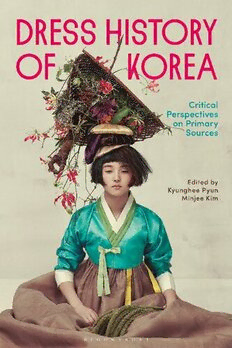
Dress History of Korea: Critical Perspectives on Primary Sources PDF
369 Pages·2023·209.247 MB·English
Most books are stored in the elastic cloud where traffic is expensive. For this reason, we have a limit on daily download.
Preview Dress History of Korea: Critical Perspectives on Primary Sources
Description:
Bringing together a wealth of primary sources and with contributions from leading experts, Dress History of Korea presents the most recent approaches to the interpretation of Korean dress. Through close analysis of an impressive range of visual, written, and material sources—some newly excavated or recently re-discovered in global museums—the book reveals how Korean clothing and accessories evolved from the Three Kingdoms to the modern era.Interdisciplinary authors discuss the close relation of Korean bodily adornments to political and economic history and place Korean dress within broader contexts such as material culture, colonization, and cultural appropriation. As in other cultures, modern Korean clothing owes many of its styles to historic dress and this process of adaptation is explored within high fashion and popular culture contexts in ways that benefit historians and curators alike.With contributions from dress and jewelry historians, as well as specialists of art history and visual culture, Dress History of Korea makes key material newly available to non-Korean speakers. This is the indispensable guide to the study of Korean dress.This volume discusses developments in Korean dress history over different periods and highlights strong connections to political and economic aspects of Korean history, from antiquity to the modern era, in essays by fourteen leading experts working in both academia and museums in the diverse fields of dress history, jewelry history, fashion studies, art history, design history, visual culture, and museum studies. The legacy of clothing as artifacts of material culture, seen in newly excavated archaeological findings and rediscovered objects in museums outside Korea, is analyzed through a perspective that compares these materials to those available in other Asian countries. The authors also discuss how the process of discovering and knowing more about dress history might have influenced contemporary designers and craft artists within and beyond Korea in a context of cultural appropriation or authentication in both high fashion and popular culture. The book provides an indispensable guide for studies of dress and fashion history, which have hitherto been less accessible for those without fluency of Korean language and classical literature. The authors summarize and analyze up-to-date interpretations of the most cutting-edge research methods and findings in Korean Studies of dress and fashion. Their work will benefit a large audience of art-loving students, faculty and researchers, costume designers, and specialists in Asian Studies.
See more
The list of books you might like
Most books are stored in the elastic cloud where traffic is expensive. For this reason, we have a limit on daily download.
